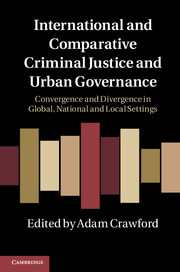 International and Comparative Criminal Justice and Urban Governance
International and Comparative Criminal Justice and Urban Governance Book contents
- Frontmatter
- Contents
- List of figures
- List of tables
- Notes on contributors
- Acknowledgements
- 1 International and comparative criminal justice and urban governance
- PART 1 International criminal justice
- PART 2 Comparative penal policies
- PART 3 Comparative crime control and urban governance
- 15 Victimhood of the national? Denationalising sovereignty in crime control
- 16 Cosmopolitan liberty in the age of terrorism
- 17 Restorative justice and states' uneasy relationship with their publics
- 18 Governing nodal governance: the ‘anchoring’ of local security networks
- 19 From the shopping mall to the street corner: dynamics of exclusion in the governance of public space
- 20 Gating as governance: the boundaries spectrum in social and situational crime prevention
- 21 French perspectives on threats to peace and local social order
- 22 The question of scale in urban criminology
- Index
- References
19 - From the shopping mall to the street corner: dynamics of exclusion in the governance of public space
from PART 3 - Comparative crime control and urban governance
Published online by Cambridge University Press: 05 June 2011
- Frontmatter
- Contents
- List of figures
- List of tables
- Notes on contributors
- Acknowledgements
- 1 International and comparative criminal justice and urban governance
- PART 1 International criminal justice
- PART 2 Comparative penal policies
- PART 3 Comparative crime control and urban governance
- 15 Victimhood of the national? Denationalising sovereignty in crime control
- 16 Cosmopolitan liberty in the age of terrorism
- 17 Restorative justice and states' uneasy relationship with their publics
- 18 Governing nodal governance: the ‘anchoring’ of local security networks
- 19 From the shopping mall to the street corner: dynamics of exclusion in the governance of public space
- 20 Gating as governance: the boundaries spectrum in social and situational crime prevention
- 21 French perspectives on threats to peace and local social order
- 22 The question of scale in urban criminology
- Index
- References
Summary
Perceptions of security and order increasingly inform how urban spaces are imagined, designed and governed. Drawing on insights from two research studies, this chapter charts the manner in which dynamics of exclusion previously confined to the shopping mall and other examples of ‘mass private property’ are gradually being extended into the public realm. It outlines the privatisation of public spaces, the emergence of novel forms of spatial exclusion and the growing importance of conditionality as the basis for access to resources, goods and services. Attracting ‘good customers’, whilst intercepting and deflecting ‘flawed consumers’, is an increasingly dominant logic of contemporary urban governance. Consideration is given to the politics of behaviour as institutionalised in the British antisocial behaviour agenda and its comparative implications. In particular, the chapter focuses on the ways in which young people as ‘non-consumers’ are problematised and policed. It is argued that strategies and technologies of ‘preventive exclusion’ deployed and developed on private property now routinely inform the governance of public spaces. Public streets are being ‘reordered’ through the banning and dispersal of those who do not conform to the consuming majority or those whose appearance jars with the prevailing vision of an ordered world in which security pervades urban environments.
- Type
- Chapter
- Information
- International and Comparative Criminal Justice and Urban GovernanceConvergence and Divergence in Global, National and Local Settings, pp. 483 - 518Publisher: Cambridge University PressPrint publication year: 2011
References
- 8
- Cited by
